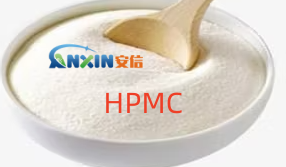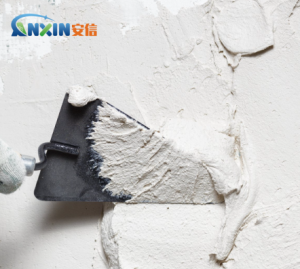Hydroxypropyl methylcellulose (HPMC) is a non-ionic cellulose ether with excellent thickening, water retention, film-forming, and dispersing properties, widely used in building materials, coatings, and pharmaceuticals. In gypsum-based building materials, the introduction of HPMC can significantly improve their workability, enhancing spreadability, water retention, and anti-sagging properties, making the material easier to use and more stable on-site.
1. Mechanism of HPMC in Gypsum Systems
Gypsum materials are mainly composed of hemihydrate gypsum as the cementitious matrix. After adding water, it hydrates to form dihydrate gypsum crystals, creating a robust network structure. Due to the rapid hardening speed and poor water retention of gypsum, problems such as shrinkage cracking, sagging, and poor adhesion easily occur during construction. The introduction of HPMC can improve the system performance through the following mechanisms:
Physical Adsorption and Network Structure Regulation: HPMC molecules interact with water molecules and the surface of gypsum crystals through hydrogen bonds, forming a viscoelastic polymer film that slows down water loss and extends the workable time of the gypsum slurry. Solution Thickening and Rheological Control: HPMC dissolves in water to form a high-viscosity solution, which improves the thixotropy of the slurry. It exhibits high viscosity and anti-sagging properties when at rest, while maintaining good fluidity under stirring or construction shear forces, facilitating application.
Hydration Process Regulation: HPMC has a certain retarding effect on the dissolution-crystallization process of hemihydrate gypsum, preventing internal stress caused by excessively rapid local crystallization and improving structural uniformity.
2. The Influence of HPMC on Gypsum Construction Performance
2.1. Improved Water Retention and Extended Working Time
Gypsum systems are prone to water loss under high temperature or dry environments, leading to surface powdering or cracking. HPMC can significantly improve the water retention rate of the system through its film-forming water-retention properties, allowing water to be fully utilized in the hydration reaction. Studies have shown that when the HPMC addition is 0.1%–0.3%, the water retention rate of the gypsum slurry can be increased from 85% to over 95%, while the working time is extended by approximately 30%–50%.
2.2. Improved Workability and Anti-Sagging Properties
HPMC increases the system’s viscosity and thixotropy, resulting in excellent troweling smoothness and surface flatness during application, preventing sagging issues on vertical surfaces. Especially in sprayed and leveling plasters, appropriate addition of HPMC significantly improves flow control and reduces the need for secondary finishing.
2.3. Enhanced Bond Strength and Surface Quality
Because HPMC forms a continuous polymer film on the surface of the hardened plaster, it enhances the interfacial bonding between the plaster and the base or finishing materials. Simultaneously, HPMC improves the pore structure distribution of the hardened plaster, resulting in a denser and smoother surface, improving the appearance quality and mechanical stability of the finished product.
2.4. Control of Setting Time and Application Schedule
Different degrees of substitution and viscosity grades of HPMC have different effects on plaster setting time. Generally, low-viscosity HPMC has a smaller effect on retarding setting, while high-viscosity products have a significant delaying effect. By controlling the amount added and the product type, the setting time of gypsum materials can be flexibly adjusted to meet the construction requirements of different processes.
3. HPMC-Modified Gypsum Performance Optimization Strategy
3.1. Rational Selection of HPMC Type and Dosage
For gypsum systems, it is recommended to use medium-to-high viscosity (40,000–80,000 mPa·s) construction-grade HPMC to balance water retention and workability. Excessive addition will lead to an overly thick paste and difficult construction; therefore, it is generally advisable to control the dosage between 0.1% and 0.3%.
3.2. Application of Compounding Technology
HPMC can be compounded with additives such as starch ether and redispersible polymer powder (RDP) to achieve synergistic optimization of rheology and adhesion. For example, starch ether can improve thixotropy, and RDP can enhance crack resistance and adhesion; the combination of the three can significantly enhance the overall workability of the gypsum system.
3.3. Customized Formulations for Different Gypsum Systems
In different applications such as plastering gypsum, leveling gypsum, and gypsum putty, HPMC plays different roles: plastering gypsum emphasizes water retention and anti-sagging, leveling gypsum emphasizes delayed setting and leveling properties, while putty requires a smooth surface and film-forming properties. Targeted selection of appropriate HPMC molecular weight and degree of substitution is key to achieving optimal workability.
HPMC has a significant modifying effect on gypsum-based materials. Through multiple mechanisms, including water retention, thickening, delayed setting, and improved rheological behavior, it significantly improves the workability and finished product quality of gypsum systems. Rational selection of HPMC type and dosage, combined with other additives for optimized formulation, is an important direction for future gypsum building material formulation design. With the promotion of green building and prefabricated construction, HPMC-modified gypsum will show broader application prospects in the field of high-performance, sustainable building materials.
Post time: Nov-07-2025

